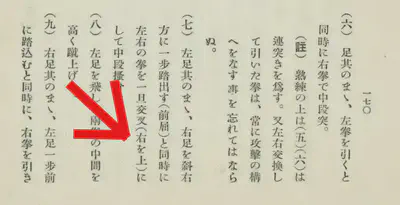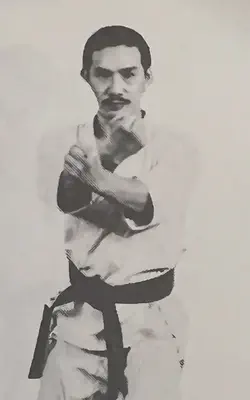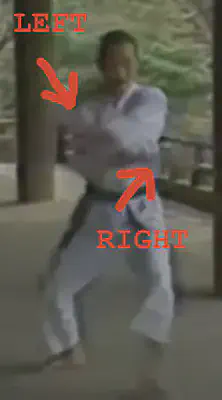Questions: April 2025 Edition
While visiting Illinois recently, one of my kohai asked me a couple of questions about Jion, which I thought I might detail here, though I’ve altered the questions a bit for clarity.
Q1: In Jion, at moves 3 and 7, when you’re stepping out into ryoken kakiwake-uke in zenkutsu-dachi, should my hands and feet stop moving at the same time?
At first blush, this seems like an obvious “yes.” After all, “foot and fist, same time!” is the rule, right? But let’s look a bit deeper.
This is a slow move with a step into zenkutsu-dachi so, unless you can defy gravity, your front foot is going to have to land while your hips and hands are still moving, right?

So let’s clarify: It’s not that the hands and feet stop moving at the same time; it’s that your upper body and lower body stop at the same time. As noted above, this is a slow step into front stance, so your foot is going to have to land before your hands are done moving, but your hips continue to turn and drop into full-front facing until your hands come to a complete stop.
(Contrast this with moves 14 and 18 in Heian Yondan. There, because you’re stepping out into kokutsu-dachi, you can keep moving your foot right up until your hands stop.)
That answers the question, but I want to dive deeper still. “Everything stops at once” is the rule, but why?
To answer that question it’s important to know what we’re doing. If everything should stop at the same time, it should be because doing so accomplishes our goal, not because it follows some rule. In other words, if there is a rule, it’s because we’re often trying to accomplish similar goals with similar methods, not because we’re trying to find applications that adhere to an arbitrary rule.
My “go-to” application of this move is identical to the similar move in Heian Yondan. We’re escaping from a double lapel grab by raising our arms between the attacker’s arms, driving his arms apart, and driving him back where we can get to him with the following techniques. In both driving the attacker’s arms apart, and in driving him back, we use not just our arm strength, but the power generated by dropping our center of gravity.
That’s the key. Because we want to add the power of our arms to the power of our dropping mass, they must be moving at the same time.
Having said that, there are places in kata where the hands move independently of the feet, or vice versa. For example, in the fifth move of Heian Shodan, the left hand shoots up into an open-handed rising block before you step forward into a right rising block. Likewise in move 22 of Heian Godan the feet move while the hands stay still in manji-uke. These both violate the “rule”, but they’re not wrong. You just need to understand the application.
Furthermore, different groups perform kata differently (gasp) and some variations seem to violate the rule unless you understand the appliation. For example, when I first learned Heian Nidan, move 14 was performed by stepping into front stance, raising the arms, and then transitioning to back stance, using the power of the shifting stance to bend the attacker forward at the waist. This looks “wrong” to most people, but makes perfect sense if that’s what you believe you’re doing.
TL;DR: Yes, everything stops moving at once, but it’s more important to understand the application than it is to “follow the rule.”
Q2: In Jion, at move 33, when you’re stepping forward from the downward “x” block in kosa-dachi into the ryoken kakiwake-uke in hidari zenkutsu dachi, which hand crosses in front?
(Note: Since the arms are angled like inside blocks at this point in the kata, “in front” is the opposite of “on top.”)
This turned out to be a really good question.
This isn’t something I consider to be a major point of the kata, so I had to think about how I do it. I cross the left hand on top, but then I got to thinking about why I do it that way, and I had to admit … I didn’t have a good reason. So I thought about it more.
The left hand is executing uchi-uke, so it would make sense to chamber it to the right hip by passing it beneath the right arm. That would cause it to pass beneath right arm when executing the block. That’s fine, but … the right arm is doing an inside block too, so why wouldn’t it chamber to the left hip under the left arm? They’re both doing an inside block, but they can’t both be on the bottom. You have to pick, so what other means might we have to decide?
Since I’m stepping forward with the left foot, passing the left hand beneath (and therefore in front) follows the “same hand, same foot” rule, but if you’ve read everything to this point you know that I value understanding the application over following the rule. So what’s the application? That’s another good question.
There are plenty of descriptions of bunkai for the downward “x” block and wedge block at moves 31-32, and plenty for the rising “x” block and flurry of blows at moves 34-37, but almost nothing for the double block at move 33. My preferred application is deflecting an attempted two-handed grab, before it lands, but that’s just me. What do the authorities say?
If you try to look it up in a book, it’s a toss up:
- Both editions of “Karate-do Kyohan”, Nakayama’s “Best Karate vol. 8”, and the JKA’s “Karate-Do Kata vol. 1”, all indicate the right hand on top.
- But Kanazawa’s “Karate - The complete kata” and Sugiyama’s “25 Shoto-kan Kata” both show or describe the left hand on top.
That didn’t help, so let’s turn to Youtube. You’re certainly going to want to watch these at reduced speed, but …
- Kanazawa, the old “blue back” JKA video, this video from the JKA hombu, this guy, and this guy all have their left arm on top.
- But Naka, Kase, Kagawa’s instructional video, and Luca Valdesi all have the right arm on top.
That didn’t help either. 🤷
Did someone mistake “right on top” for “right in front”? Possibly, but it’s definitely not a mistranslation. Funakoshi’s original text reads “右を上”, which is fairly unambiguous.

But here’s where it gets really interesting. Let’s look at Tanaka.
- In Best Karate, where it shows and describes the right hand being on top, Tanaka is the one being photographed.
- But in the JKA video on Jion, the one with the beautiful temple, it’s Tanaka again, but this time with the left hand on top.
| Tanaka in Best Karate | Tanaka’s actual performance |
|---|---|
 |
 |
Wait … what? How can that be? Unless it doesn’t matter? 🤦
Is there any evidence for that?
Yep …
Check out this video of Nishiyama teaching a seminar on Jion back in 1997. The video is 90 minutes long, but the relevant part is the three minutes between 1:05 and 1:08. Again, you may want to slow it down to half speed at these points but here’s how it breaks down.
- 1:05:51: The demonstrator crosses his left hand on top. Nishiyama is watching and says nothing.
- 1:06:01: Nishiyama grabs the demonstrators arms while explaining an unrelated point and crosses them with the right hand on top.
- 1:06:12: Between here and 1:07:30, the demonstrator does it three more times, always with the left hand on top, and Nishiyama says nothing.
- 1:07:33: Nishiyama demonstrates himself, and clearly crosses his right hand on top of his left.
- 1:07:57: Nishiyama demonstrates slowly several times, always with the right hand on top, then calls up the demonstrator who does it with his left hand on top again and says nothing.
And that’s not the only example of indifference from a big-name instructor. Check out this video of Kanazawa from 1994.
- 1:17: The demonstrator crosses right hand on top.
- 3:17: Kanazawa has his left hand on top.
- 9:23: Demonstrator with right arm on top again.
So what does all this mean? I’d say it depends on what you think is important.
Funakoshi was clear, all the way back in 1935, that the right hand should be on top. Maybe it’s not important. Maybe that’s just the way he did it and someone wrote it down. But, of all the things to document, that made it into the documentation, so I’m inclined to think someone thought it was important at the time.
Of course, everyone knows that things have changed since Funakoshi’s time, and it’s pretty clear that people have begun doing this particular thing however they want. In the absence of a clear application, it’s really hard to say that any particular way of doing it is “wrong.” (i.e. Until I know which way you’re doing it, and why you’re doing it that way, it’s impossible to test which way works better.)
I’m curious if anyone has received specific instruction on this point, what it was, and from whom, or whether everyone was just told “do a double inside block” and left to figure it out for themselves.
Let me know your thoughts.